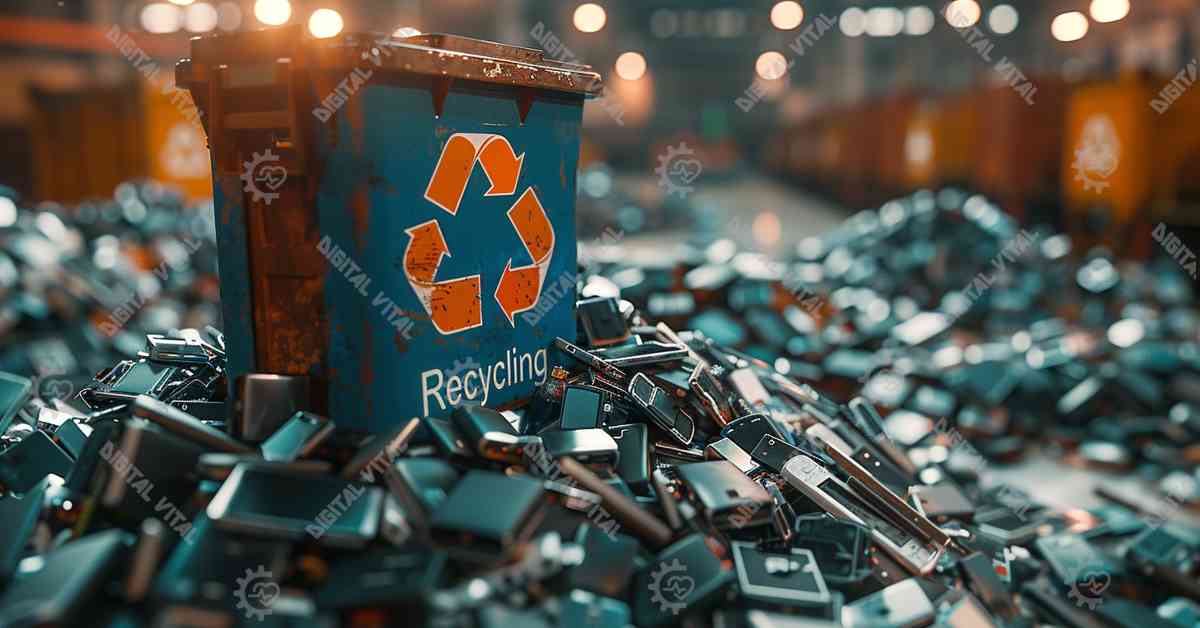Electronic trash, commonly known as e-waste, represents one of the fastest-growing waste streams in the world. The rapid proliferation of electronic devices, combined with shorter product life cycles and increasing consumer demand, has led to a significant increase in electronic trash. This comprehensive article explores the environmental and health impacts of electronic trash, current challenges in e-waste management, innovative solutions, and future directions.
Keywords: electronic trash, e-waste, environmental impact, recycling, waste management, hazardous materials, circular economy
Table of Contents
Introduction to Electronic Trash
Electronic trash, or e-waste, encompasses discarded electronic devices and components, including computers, smartphones, televisions, and household appliances. These items often contain hazardous materials like lead, mercury, and cadmium, which can leach into the environment if not properly managed. The increasing rate of electronic consumption has exacerbated the e-waste problem, creating significant environmental and health challenges.
The Scale of the Problem
According to the Global E-waste Monitor 2020, approximately 53.6 million metric tonnes of e-waste were generated worldwide in 2019, with only 17.4% being recycled properly (Global E-waste Monitor 2020). This alarming statistic highlights the urgent need for improved e-waste management practices to mitigate the growing crisis.

Environmental and Health Impacts of Electronic Trash
The improper disposal of electronic trash has severe environmental and health consequences. Understanding these impacts is crucial for developing effective management strategies.
Environmental Impact
Electronic trash contains a variety of toxic substances that can contaminate soil, water, and air. When e-waste is improperly disposed of, such as through open burning or landfilling, harmful chemicals are released into the environment, posing significant risks to ecosystems and human health. For instance, heavy metals like lead and cadmium can accumulate in the soil, disrupting plant growth and entering the food chain. Studies have shown that e-waste can contribute to air pollution and the accumulation of hazardous substances in the environment (Grant et al., 2013).
Health Risks
Exposure to hazardous materials in electronic trash can lead to serious health issues, including respiratory problems, neurological disorders, and cancers. Informal recycling practices, often prevalent in developing countries, expose workers and nearby communities to dangerous levels of toxic substances. A study by the World Health Organization (WHO) emphasized the detrimental health effects of e-waste on children, who are particularly vulnerable to these toxic exposures (WHO, 2021).
Current Challenges in E-Waste Management
Managing electronic trash presents numerous challenges, ranging from collection and recycling to addressing the health and environmental impacts. These challenges must be tackled comprehensively to mitigate the adverse effects of e-waste.
Collection and Recycling
The collection and recycling of electronic trash are fraught with difficulties. Many consumers are unaware of how to dispose of their old electronics properly, leading to low recycling rates. Additionally, the infrastructure for collecting and processing e-waste is often inadequate, particularly in developing countries. Effective e-waste management requires efficient collection systems and advanced recycling technologies to recover valuable materials and minimize environmental harm.
Economic and Logistical Challenges
Recycling e-waste is a complex process that requires significant infrastructure and investment. The lack of efficient collection systems, coupled with the economic viability of recycling operations, poses a major barrier. Many countries lack the necessary facilities to handle the growing volume of e-waste, leading to its improper disposal or export to regions with less stringent regulations. Effective e-waste management also involves significant logistical challenges, including the transportation and processing of large volumes of waste materials.
Regulatory and Policy Issues
Regulatory frameworks for e-waste management vary widely across different countries, leading to inconsistencies in how electronic trash is handled. While some regions have implemented stringent regulations to ensure the safe disposal and recycling of e-waste, others lack comprehensive policies. This disparity can result in the illegal export of e-waste to countries with less stringent regulations, where it is often processed under hazardous conditions. The development and enforcement of robust regulatory frameworks are crucial for effective e-waste management.
Innovations in E-Waste Management
Despite the challenges, several innovative approaches and technologies have been developed to improve e-waste management. These innovations aim to enhance recycling efficiency, recover valuable materials, and reduce the environmental footprint of electronic devices.
Advanced Recycling Technologies
Advanced recycling technologies have been developed to recover valuable metals and materials from electronic trash. Techniques such as hydrometallurgical and pyrometallurgical processes enable the extraction of precious metals like gold, silver, and platinum from electronic components. Additionally, mechanical recycling methods, including shredding and separation, are used to process large volumes of e-waste efficiently. For example, the University of New South Wales (UNSW) has developed a microfactory that uses a combination of mechanical and thermal processes to recycle e-waste into valuable materials (UNSW Microfactory).
Circular Economy Models
The circular economy model emphasizes the importance of designing products with their end-of-life in mind, promoting reuse, repair, and recycling. By extending the lifecycle of electronic devices and reducing the demand for virgin materials, the circular economy can significantly reduce e-waste generation. Companies like Fairphone are leading the way by producing modular smartphones designed for easy repair and upgrading. This approach not only reduces e-waste but also encourages consumers to adopt more sustainable consumption habits (Fairphone).
Policy and Regulation
Effective policies and regulations are crucial for managing electronic trash. Extended Producer Responsibility (EPR) is a policy approach that holds manufacturers accountable for the entire lifecycle of their products, including end-of-life disposal. EPR encourages producers to design more sustainable products and invest in recycling infrastructure. The European Union’s Waste Electrical and Electronic Equipment (WEEE) Directive is an example of successful legislation that has improved e-waste management across member states. The directive sets collection and recycling targets, ensuring that a significant portion of e-waste is processed properly (European Commission WEEE Directive).
Public Awareness and Education
Raising public awareness about the importance of proper e-waste disposal and recycling is essential. Educational campaigns and initiatives can inform consumers about the environmental and health impacts of e-waste and encourage responsible behavior. Programs like the E-Stewards Certification provide guidance and certification for responsible recycling practices, helping consumers and businesses choose environmentally friendly options for e-waste disposal (E-Stewards).

Literature Review on Electronic Trash
A thorough review of recent articles and patents reveals significant advancements and ongoing research in e-waste management. This literature review highlights key findings and trends in the field.
Recent studies have explored the environmental and health impacts of electronic trash, as well as innovative recycling technologies and policy approaches. For instance, Grant et al. (2013) conducted a systematic review on the health consequences of exposure to e-waste. Their findings indicate that e-waste exposure is linked to adverse health effects, including respiratory issues and neurological damage, particularly in vulnerable populations such as children and informal recycling workers (Grant et al., 2013).
The Global E-waste Monitor 2020 provides a comprehensive analysis of global e-waste generation and management practices. The report highlights the urgent need for improved recycling infrastructure and the potential of the circular economy to mitigate e-waste challenges. It also emphasizes regional disparities in e-waste management and calls for international cooperation to address these issues (Global E-waste Monitor 2020).
Pinto (2008) discusses the hazards associated with e-waste and the challenges faced in its management. The article provides insights into the environmental and health impacts of e-waste and highlights the need for effective regulatory frameworks to ensure safe disposal and recycling practices (Pinto, 2008).
Recent patents have focused on innovative methods for recovering valuable materials from e-waste and improving recycling efficiency. Patent US10399285B2 describes a method for recovering valuable metals from e-waste using a combination of hydrometallurgical and pyrometallurgical processes. This technique aims to improve the efficiency and yield of metal recovery from discarded electronic components (Patent US10399285B2).
Patent US10875361B2 outlines a system for the automated sorting and recycling of e-waste using advanced sensor technologies and robotic arms. The system is designed to enhance the efficiency and accuracy of e-waste processing, reducing the reliance on manual labor and improving recycling outcomes (Patent US10875361B2).
Patent EP3310597A1 details a process for recycling plastic materials from e-waste, focusing on the separation and purification of different types of plastics. This process aims to increase the recyclability of plastic components in e-waste and reduce the environmental impact of plastic waste (Patent EP3310597A1).
Future Directions in E-Waste Management
The field of e-waste management is continually evolving, with new technologies, methodologies, and policy approaches emerging to address the challenges of electronic trash. Here are some future directions that hold significant promise.
Technological Innovations
Technological innovations play a critical role in advancing e-waste management. Emerging technologies such as artificial intelligence (AI), blockchain, and the Internet of Things (IoT) offer new opportunities for enhancing sustainability. AI can improve the efficiency of e-waste sorting and recycling processes by automating tasks and optimizing resource recovery. Blockchain technology can enhance transparency and accountability in e-waste management, ensuring that electronic devices are properly recycled and hazardous materials are safely disposed of. IoT devices can monitor the condition of electronic products and facilitate their repair, reuse, and recycling.
Integrating Sustainability into Product Design
Integrating sustainability into product design is essential for reducing e-waste generation. This involves designing products for durability, reparability, and recyclability, as well as using sustainable materials. By incorporating eco-design principles, manufacturers can extend the lifespan of electronic devices and reduce their environmental impact. Companies like Fairphone are leading the way by producing modular smartphones designed for easy repair and upgrading. This approach not only reduces e-waste but also encourages consumers to adopt more sustainable consumption habits (Fairphone).
Strengthening Global Partnerships
Global partnerships and collaboration are essential for addressing the complex and interconnected challenges of e-waste management. International organizations, governments, businesses, civil society, and individuals must work together to develop and implement effective e-waste management strategies. Multilateral agreements, such as the Basel Convention, provide frameworks for international cooperation on hazardous waste management, including e-waste (Basel Convention).
Enhancing Public Awareness and Education
Raising public awareness and education about the importance of proper e-waste disposal and recycling is crucial for driving behavioral change. Educational campaigns and initiatives can inform consumers about the environmental and health impacts of e-waste and encourage responsible behavior. Programs like the E-Stewards Certification provide guidance and certification for responsible recycling practices, helping consumers and businesses choose environmentally friendly options for e-waste disposal (E-Stewards).
Policy and Regulatory Improvements
Effective policies and regulations are crucial for managing e-waste. Extended Producer Responsibility (EPR) is a policy approach that holds manufacturers accountable for the entire lifecycle of their products, including end-of-life disposal. EPR encourages producers to design more sustainable products and invest in recycling infrastructure. The European Union’s Waste Electrical and Electronic Equipment (WEEE) Directive is an example of successful legislation that has improved e-waste management across member states. The directive sets collection and recycling targets, ensuring that a significant portion of e-waste is processed properly (European Commission WEEE Directive).
Conclusion
Electronic trash is a growing global challenge that requires comprehensive and innovative solutions. From technological advancements and policy improvements to public awareness and global partnerships, a multifaceted approach is essential for effective e-waste management. The literature review highlights significant advancements in the field and ongoing research efforts to address the environmental and health impacts of e-waste.
For small businesses, employees, job seekers, and students interested in exploring the potential of e-waste management, DigitalVital offers comprehensive services to help you navigate and succeed in this evolving landscape. Whether you need a CV review, publishing support, or specialized further education, we are here to assist you.
Visit DigitalVital Hub to learn more about our consultancy services, and stay ahead of the curve by integrating the latest advancements in e-waste management into your professional toolkit. Explore other articles on our platform to stay updated on the latest trends and insights in e-waste management and related fields.

